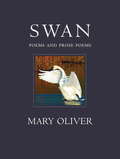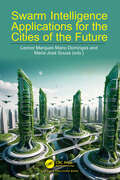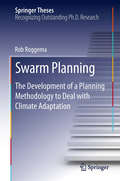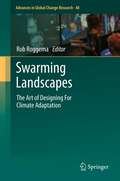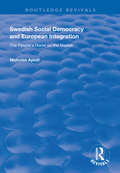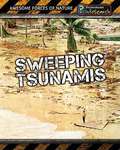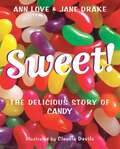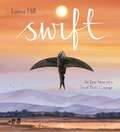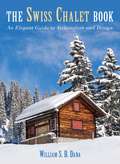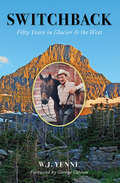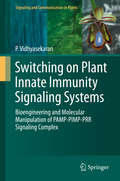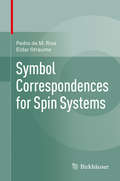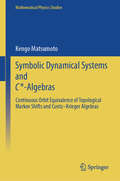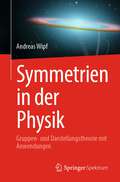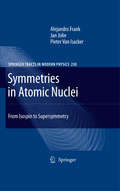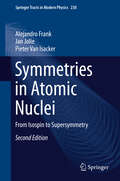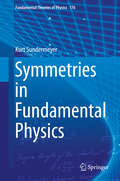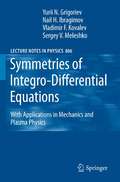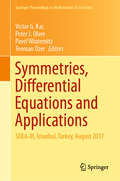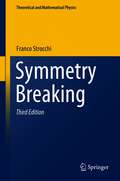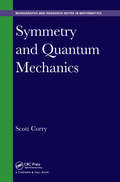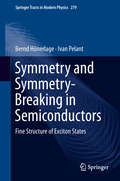- Table View
- List View
Swamplife: People, Gators, and Mangroves Entangled in the Everglades (A Quadrant Book)
by Laura A. OgdenLittle in North America is wilder than the Florida Everglades—a landscape of frightening reptiles, exotic plants in profusion, swarms of mosquitoes, and unforgiving heat. And yet, even from the early days of taming the wilderness with clearing and drainage, the Everglades has been considered fragile, unique, and in need of restorative interventions. Drawing on a decade of fieldwork with hunters in the Everglades, Laura A. Ogden explores the lives and labors of people, animals, and plants in this most delicate and tenacious ecosystem.Today, the many visions of the Everglades—protectionist, ecological, commercial, historical—have become a tangled web of contradictory practices and politics for conservation and for development. Yet within this entanglement, the place of people remains highly ambivalent. It is the role of people in the Everglades that interests Ogden, as she seeks to reclaim the landscape&’s long history as a place of human activity and, in doing so, discover what it means to be human through changing relations with other animals and plant life. Ogden tells this story through the lives of poor rural whites, gladesmen, epitomized in tales of the Everglades&’ most famous outlaws, the Ashley Gang. With such legends and lore on one side, and outsized efforts at drainage and development on the other, Swamplife strikes a rare balance, offering a unique insight into the hidden life of the Everglades—and into how an appreciation of oppositional culture and social class operates in our understanding of wilderness in the United States.
Swan
by Mary OliverWidely regarded as the "rock star" of American poetry, Mary Oliver is a writer whose words have long had the power to move countless readers. Regularly topping the national poetry best-seller list and drawing thousands to her sold-out readings across the coutnry, Oliver is unparalleled in her impact. As noted in the Los Angeles Times, so many "go to her for solace, regeneration and inspiration" that it is not surprising Vice President Joe Biden chose to read one of her poems during the 9/11 remembrance at Ground Zero. Few poets express the complexities of human experience as skillfully as Mary Oliver. This volume, Oliver's twenty-first book of poetry, contains all new poems on her classic themes. Here, readers will find the deep spiritual sustenance that imbues her writing on nature, love, mortality, and grief. As always, Oliver is an accomplished guide to the rarest and most exquisite insights of the natural world. Ranking "among the finest poets the English language has ever produced," according to the Weekly Standard, Oliver offers us lyrics of great depth and beauty that continue her lifelong work of loving the world.
Swarm Intelligence Applications for the Cities of the Future
by Maria José Sousa Leonor Marques Mano DomingosThis book explores the transformative power of swarm intelligence and digital innovations in shaping the cities of the future. It presents a comprehensive analysis of how social learning, citizen engagement, advanced technology, design, construction, planning and public policies converge to create cities that are sustainable, resilient, and inclusive.The initial chapters stress the importance of collective intelligence in urban development, using technologies like Virtual Reality to increase citizen participation and democratise decision-making. Public policies play a key role in driving the digital transformation needed for greener cities, with frameworks and tools to enhance transparency and accountability. Digital technologies in policymaking ensure that policies are adaptive, data-driven, and responsive to real-time challenges. Internet of Things systems are explored for their role in improving public safety, urban resilience, and energy efficiency through digital twins, blockchain, and sensor networks. Swarm intelligence is highlighted for optimising energy management, reducing consumption, and promoting renewable resources. Healthcare integration into urban planning and sustainability is also discussed, with a comparative analysis of cities showing how tech innovation enhances resilience against climate change. Swarm intelligence beyond cities is also explored, such as for disaster response, healthcare, environmental conservation, and agriculture. Autonomous systems like drones and nanobots are shown to improve efficiency across various sectors.Overall, this book advocates for a holistic approach to urban development, integrating digital technologies and collective intelligence to create cities that are technologically advanced, socially equitable, and environmentally sustainable.
Swarm Planning
by Rob RoggemaThis book shows that the problem of climate adaptation, which is described in social planning terms as 'wicked,' is at odds with the contemporary practice of spatial planning. The author proposes a new adjusted framework which is more adaptable to unpredictable, wicked, dynamic and non-linear processes. The inspiration for this new method is the behaviour of swarms: bees, ants, birds and fish are capable of self-organization, which enables the system to become less vulnerable to sudden environmental changes. The framework proposed in Swarm Planning consists of these four elements: Two levels of complexity, the first being the whole system and the second its individual components. Each of these has different attributes for adapting to change. Five layers, consisting of networks, focal points, unplanned space, natural resources and emerging occupation patterns. Each layer has its own spatial dynamic, and each is connected to a spatial scale. Non-linear processes, which emerge in different parts of the framework and include emerging patterns, connectedness and tipping points among others. Two planning processes; the first, 'from small to large' works upward from the slowest changing elements to more rapidly-changing ones. The second, 'on the list of partners' addresses each layer from networks through emerging occupation patterns. Swarm Planning applies this framework to a series of pilot studies, and appraises its performance using criteria for an adaptive landscape. The results show that the use of the Swarm Planning Framework reduces the vulnerability of landscapes as well as the impact of climate hazards and disasters, improves response to unexpected hazards and contains adaptation strategies. "This book is a must for planners in government and the private sector as it outlines the concept, strategies and techniques for swarm planning. It is also an important guide for policymakers looking to engage communities in a dialogue about the adaptation planning process. " Professor John Martin, La Trobe University "The ultimate value of the book lies in encouraging the planning community to consider options that go far beyond those offered by business-as-usual planning methodologies developed for a set of operating conditions that are fast becoming obsolete. As such it makes an important and much needed contribution to the field. " Assistant Professor Dr. Chrisna du Plessis, University of Pretoria
Swarming Landscapes
by Rob RoggemaThis book advocates a fresh approach to planning that anticipates, rather than reacts to, the changes in climate currently in process. Today's spatial planning procedures rely on historical evidence instead of preparing for factors that by definition lie in the future, yet which are relatively uncontroversial: shortages of water, sea level rise and rises in average temperatures being but three examples. Arguing for more flexibility, the contributors view 'complexity' as the key to transforming the way we plan in order to better equip us to face uncertainties about our future environment.
Swedish Social Democracy and European Integration: The People's Home on the Market (Routledge Revivals)
by Nicholas AylottFirst published in 1999, this volume why Europe’s arguably most successful political party, the Swedish Social Democratic Party, become so divided over European integration. Why were its grass-roots so reluctant to embrace EU membership and why did a Social Democratic government decide to stand aside from the launch of the single European currency? What connection is there between Europe and the Swedish model of political economy? While much has been written in English on Swedish Social Democracy, little of this literature has dealt with its difficulties during the 1990s and especially with its acute problems over Europe. This book fills that gap. Using original, primary data, Nicholas Aylott addresses the topic from macro and micro-political perspectives, taking account of historical, cultural, geopolitical and economic constraints, but also the interests and calculations of key individuals at critical junctures. It places the experience of Swedish Social Democracy into a broad comparative framework, drawing especially from the experiences of its Scandinavian sister parties. Up-to-date analysis of the party’s debate on EMU is included.
Sweeping Tsunamis
by Louise Spilsbury Richard SpilsburyThis book is all about tsunamis. It explains what causes a tsunami, where they happen, whether they can be predicted and what to do when a tsunami happens.
Sweet!: The Delicious Story of Candy
by Jane Drake Ann LoveThrough time and across continents, stories of sweets and their inventors intrigue and entertain us. Learn about primal sweets — from honey, sweet milk, and nuts to sugar candy, chocolate, and “sweet” stories of success. Sweet! The Delicious Story of Candy takes us through history from 4,000 B.C., when islanders in Papua New Guinea cut sugarcane for its sap, and 2,600 B.C., when the first-known beekeepers produced honey to embalm the dead, to 500 A.D., when the Chinese made pear and plum syrups from unripe fruit, and all the way through to the world’s first chocoholics and modern-day candy factories.From cravings to the scoop on ice cream, Ann Love and Jane Drake present a comprehensive and irresistible story of candy through the ages, complemented by a detailed timeline and playful illustrations from artist Claudia Dávila.
Swift: An Epic Story of a Small Bird's Courage
by Lorna HillSwift feels safe tucked up in his nest. But when all the other birds fly to a new home on the other side of the world, Swift doesn't want to be left behind. It's a treacherous journey across land and sea and there's a storm coming ... Will Swift find the courage to spread his wings? A moving story about leaving home in pursuit of safety, friendship and adventure, inspired by the 22-000 mile journey swifts make every year. Beautifully brought to life by debut author-illustrator and winner of the Carmelite Prize 2021, Lorna Hill.
Swiss Chalet Book: An Elegant Guide to Architecture and Design
by William S DanaHere William S. B. Dana, B.S., presents an in-depth and precise depiction of the breathtaking architectural masterpieces known as the Swiss Chalets. The culmination of elaborate conversations with the designers, the builders, and the experts on these spectacular buildings, here is a piece of design history that is not to be missed.A style of German origin, Swiss Chalets were best known for their large windows, ornate carvings, and balconies. Often they were brightly painted, and had gabled roofs with great overhanging eaves. These stunning aristocratic homes decorated the Swiss countryside in the nineteenth century, and later could be seen throughout the rest of the world. New Chalets, as they were called, rose up in Norway and Sweden, and finally even crossed the Atlantic, appearing in places as unexpected as Ohio and New Jersey.Through delicate language and lines, Dana expresses both the science and the art behind the simple structural elements and the most complex details of the chalets. This book, a 1913 original, displays diagrams, architectural plans, and photographs to best convey the different fundamentals and models of Swiss Chalets. The author’s research of this beautiful art form cultivates knowledge and appreciation of this great architectural style.
Switchback: Fifty Years in Glacier & the West
by W.J. YenneHis half-century career took him from the Idaho panhandle to the Grand Canyon, but William J. Yenne is best remembered for his decades in Montana's Glacier National Park. Widely recognized as the most accomplished and knowledgeable outdoorsman to ride the Glacier backcountry, Yenne knew each mile of the park's trails intimately and could identify every mountain peak at a glance. He was also a renowned storyteller. Many recall his amusing and fascinating yarns, spun around campfires or from his saddle on long trail rides. Those iconic tales and more are preserved in this expanded edition, updated with previously unpublished photos and stories transcribed from conversations and letters to friends.
Switching on Plant Innate Immunity Signaling Systems
by P. VidhyasekaranThis book presents the ways and means to switch on plant immune signaling systems using PAMP-PIMP-PRR signaling complex for crop disease management. It also describes bioengineering approaches to develop transgenic plants expressing enhanced disease resistance using genes encoding PAMPs, PRRs and transcription factors and genes involved in generation of PIMPs/HAMPs. It also discusses recent commercial development of PAMP products to switch on plant innate immunity for crop disease management. These unique approaches have been described with more than 100 figures and illustrations and these would make this book attractive for researchers and students to buy this book.
Symbiotic Soil Microorganisms: Biology and Applications (Soil Biology #60)
by Ajit Varma Neeraj Shrivastava Shubhangi MahajanThis book explores microbial symbiosis, with a particular focus on soil microorganisms, highlighting their application in enhancing plant growth and yield. It addresses various types of bacterial and fungal microbes associated with symbiotic phenomena, including rhizobium symbiosis, arbuscular mycorrhizal symbiosis, ectomycorrhizal symbiosis, algal/lichen symbiosis, and Archeal symbiosis.Presenting strategies for employing a diverse range of bacterial and fungal symbioses in nutrient fortification, adaptation of plants in contaminated soils, and mitigating pathogenesis, it investigates ways of integrating diverse approaches to increase crop production under the current conventional agroecosystem.Providing insights into microbial symbioses and the challenges of adopting a plant-microbe synergistic approach towards plant health, this book is a valuable resource for researchers, graduate students and anyone in industry working on bio-fertilizers and their agricultural applications.
Symbol Correspondences for Spin Systems
by Pedro de M. Rios Eldar StraumeIn mathematical physics, the correspondence between quantum and classical mechanics is a central topic, which this book explores in more detail in the particular context of spin systems, that is, SU(2)-symmetric mechanical systems. A detailed presentation of quantum spin-j systems, with emphasis on the SO(3)-invariant decomposition of their operator algebras, is first followed by an introduction to the Poisson algebra of the classical spin system and then by a similarly detailed examination of its SO(3)-invariant decomposition. The book next proceeds with a detailed and systematic study of general quantum-classical symbol correspondences for spin-j systems and their induced twisted products of functions on the 2-sphere. This original systematic presentation culminates with the study of twisted products in the asymptotic limit of high spin numbers. In the context of spin systems it shows how classical mechanics may or may not emerge as an asymptotic limit of quantum mechanics. The book will be a valuable guide for researchers in this field and its self-contained approach also makes it a helpful resource for graduate students in mathematics and physics.
Symbolic Dynamical Systems and C*-Algebras: Continuous Orbit Equivalence of Topological Markov Shifts and Cuntz–Krieger Algebras (Mathematical Physics Studies)
by Kengo MatsumotoThis book presents the interplay between topological Markov shifts and Cuntz–Krieger algebras by providing notations, techniques, and ideas in detail. The main goal of this book is to provide a detailed proof of a classification theorem for continuous orbit equivalence of one-sided topological Markov shifts. The continuous orbit equivalence of one-sided topological Markov shifts is classified in terms of several different mathematical objects: the étale groupoids, the actions of the continuous full groups on the Markov shifts, the algebraic type of continuous full groups, the Cuntz–Krieger algebras, and the K-theory dates of the Cuntz–Krieger algebras. This classification result shows that topological Markov shifts have deep connections with not only operator algebras but also groupoid theory, infinite non-amenable groups, group actions, graph theory, linear algebras, K-theory, and so on. By using this classification result, the complete classification of flow equivalence in two-sided topological Markov shifts is described in terms of Cuntz–Krieger algebras. The author will also study the relationship between the topological conjugacy of topological Markov shifts and the gauge actions of Cuntz–Krieger algebras.
Symmetrien in der Physik: Gruppen- und Darstellungstheorie mit Anwendungen
by Andreas WipfDas vorliegende Buch führt durch die Symmetrien in der Physik: Es werden wichtige Gruppen und Symmetrien aus der Molekülphysik, der Festkörperphysik und (Quanten-)Feldtheorie vorgestellt und behandelt. Das Buch richtet sich an Studierende der Physik, die entweder die Vorlesung zur Gruppen- und Darstellungstheorie hören oder sich im Rahmen einer Bachelor-, Master- oder Doktorarbeit in Gruppentheorie und Symmetrien in der Physik einlesen möchten. Behandelt werden u.a. endliche und kontinuierliche Gruppen sowie Lie-Algebren und deren Darstellungen, aber auch klassische und quantisierte Feldtheorien, Eichtheorien und konforme Feldtheorien. Der Autor verbindet in den Kapiteln die mathematischen Grundlagen mit der physikalischen Anwendung. Beispiele, Aufgaben und Zwischenfragen helfen Leserinnen und Lesern dabei, ihr Verständnis zu überprüfen..
Symmetries in Atomic Nuclei
by Pieter Van Isacker Jan Jolie Alejandro FrankSymmetries in Atomic Nuclei aims to present an overview of recent applications of symmetry to the description of atomic nuclei. Special care is given to a pedagogical introduction of symmetry concepts using simple examples. After a historical overview of the applications of symmetry in nuclear physics, progress in the field during the last decade is reviewed. Special emphasis is put on the introduction of neutron-proton and boson-fermion degrees of freedom. Their combination leads to a supersymmetric description of pairs and quartets of nuclei. Both theoretical aspects and experimental signatures of dynamical (super)symmetries are carefully discussed. Case studies show how these symmetries are displayed by real atomic nuclei which have been studied experimentally using state-of-the art spectroscopy. This book focuses on nuclear structure physics and has been written by active investigators in the field, but its scope is wider and is intended for final-year or post-graduate students and researchers interested in understanding the power and beauty of symmetry methods in physics.
Symmetries in Atomic Nuclei: From Isospin to Supersymmetry (Springer Tracts in Modern Physics #230)
by Jan Jolie Alejandro Frank Pieter Van IsackerThe revised edition of this established work presents an extended overview of recent applications of symmetry to the description of atomic nuclei, including a pedagogical introduction to symmetry concepts using simple examples. Following a historical overview of the applications of symmetry in nuclear physics, attention turns to more recent progress in the field. Special emphasis is placed on the introduction of neutron-proton and boson-fermion degrees of freedom. Their combination leads to a supersymmetric description of pairs and quartets of nuclei. Expanded and updated throughout, the book now features separate chapters on the nuclear shell model and the interacting boson model, the former including discussion of recent results on seniority in a single-j shell. Both theoretical aspects and experimental signatures of dynamical (super)symmetries are carefully discussed. This book focuses on nuclear structure physics, but its broad scope makes it suitable for final-year or post-graduate students and researchers interested in understanding the power and beauty of symmetry methods in physics.Review of the 1st Edition:"The subject of this book, symmetries in physical systems, with particular focus on atomic nuclei, is of the utmost importance in modern physical science. In contrast to most treatments, frequently characterized by fearsome formalism, this book leads the reader step-by-step, in an easily understandable way, through this fascinating field...this book is remarkably accessible to both theorists and experimentalists. Indeed, I view it as essential reading for experimental nuclear structure physicists. This is one of the finest volumes on this subject I have ever encountered." Prof. R.F. Casten, Yale University
Symmetries in Fundamental Physics (Fundamental Theories of Physics #176)
by Kurt SundermeyerOver the course of the last century it has become clear that both elementary particle physics and relativity theories are based on the notion of symmetries. These symmetries become manifest in that the "laws of nature" are invariant under spacetime transformations and/or gauge transformations. The consequences of these symmetries were analyzed as early as in 1918 by Emmy Noether on the level of action functionals. Her work did not receive due recognition for nearly half a century, but can today be understood as a recurring theme in classical mechanics, electrodynamics and special relativity, Yang-Mills type quantum field theories, and in general relativity. As a matter of fact, as shown in this monograph, many aspects of physics can be derived solely from symmetry considerations. This substantiates the statement of E.P.Wigner "... if we knew all the laws of nature, or the ultimate Law of nature, the invariance properties of these laws would not furnish us new information." Thanks to Wigner we now also understand the implications of quantum physics and symmetry considerations: Poincare invariance dictates both the characteristic properties of particles (mass, spin, ...) and the wave equations of spin 0, 1/2, 1, ... objects. Further, the work of C.N.Yang and R.Mills reveals the consequences of internal symmetries as exemplified in the symmetry group of elementary particle physics. Given this pivotal role of symmetries it is thus not surprising that current research in fundamental physics is to a great degree motivated and inspired by considerations of symmetry.The treatment of symmetries in this monograph ranges from classical physics to now well-established theories of fundamental interactions, to the latest research on unified theories and quantum gravity.
Symmetries of Integro-Differential Equations: With Applications in Mechanics and Plasma Physics
by N. Kh. Ibragimov Sergey V. Meleshko Yurii N. Grigoriev Vladimir F. KovalevThis book aims to coherently present applications of group analysis to integro-differential equations in an accessible way. The book will be useful to both physicists and mathematicians interested in general methods to investigate nonlinear problems using symmetries. Differential and integro-differential equations, especially nonlinear, present the most effective way for describing complex processes. Therefore, methods to obtain exact solutions of differential equations play an important role in physics, applied mathematics and mechanics. This book provides an easy to follow, but comprehensive, description of the application of group analysis to integro-differential equations. The book is primarily designed to present both fundamental theoretical and algorithmic aspects of these methods. It introduces new applications and extensions of the group analysis method. The authors have designed a flexible text for postgraduate courses spanning a variety of topics.
Symmetries, Differential Equations and Applications: Sdea-iii, Istanbul, Turkey, January 2017 (Springer Proceedings in Mathematics & Statistics #266)
by Pavel Winternitz Peter J. Olver Victor G. Kac Teoman ÖzerBased on the third International Conference on Symmetries, Differential Equations and Applications (SDEA-III), this proceedings volume highlights recent important advances and trends in the applications of Lie groups, including a broad area of topics in interdisciplinary studies, ranging from mathematical physics to financial mathematics. The selected and peer-reviewed contributions gathered here cover Lie theory and symmetry methods in differential equations, Lie algebras and Lie pseudogroups, super-symmetry and super-integrability, representation theory of Lie algebras, classification problems, conservation laws, and geometrical methods. The SDEA III, held in honour of the Centenary of Noether’s Theorem, proven by the prominent German mathematician Emmy Noether, at Istanbul Technical University in August 2017 provided a productive forum for academic researchers, both junior and senior, and students to discuss and share the latest developments in the theory and applications of Lie symmetry groups. This work has an interdisciplinary appeal and will be a valuable read for researchers in mathematics, mechanics, physics, engineering, medicine and finance.
Symmetries, Integrable Systems and Representations
by Sophie Morier-Genoud Kenji Iohara Bertrand RémyThis volume is the result of two international workshops; Infinite Analysis 11 - Frontier of Integrability - held at University of Tokyo, Japan in July 25th to 29th, 2011, and Symmetries, Integrable Systems and Representations held at Université Claude Bernard Lyon 1, France in December 13th to 16th, 2011. Included are research articles based on the talks presented at the workshops, latest results obtained thereafter, and some review articles. The subjects discussed range across diverse areas such as algebraic geometry, combinatorics, differential equations, integrable systems, representation theory, solvable lattice models and special functions. Through these topics, the reader will find some recent developments in the field of mathematical physics and their interactions with several other domains.
Symmetry Breaking: A Non-perturbative Outlook (Theoretical and Mathematical Physics #732)
by Franco StrocchiThe third edition of the by now classic reference on rigorous analysis of symmetry breaking in both classical and quantum field theories adds new topics of relevance, in particular the effect of dynamical Coulomb delocalization, by which boundary conditions give rise to volume effects and to energy/mass gap in the Goldstone spectrum (plasmon spectrum, Anderson superconductivity, Higgs phenomenon). The book closes with a discussion of the physical meaning of global and local gauge symmetries and their breaking, with attention to the effect of gauge group topology in QCD. From the reviews of the first edition: It is remarkable to see how much material can actually be presented in a rigorous way (incidentally, many of the results presented are due to Strocchi himself), yet this is largely ignored, the original heuristic derivations being, as a rule, more popular. - At each step he strongly emphasizes the physical meaning and motivation of the various notions introduced [...] a book that fills a conspicuous gap in the literature, and does it rather well. It could also be a good basis for a graduate course in mathematical physics. J.-P. Antoine, Physicalia 28/2, 2006 Despite many accounts in popular textbooks and a widespread belief, the phenomenon is rather subtle, requires an infinite set of degrees of freedom and an advanced mathematical setting of the system under investigation. [...] The mathematically oriented graduate student will certainly benefit from this thorough, rigorous and detailed investigation. G. Roepstorff, Zentralblatt MATH, Vol. 1075, 2006 From the reviews of the second edition: This second edition of Strocchi’s Symmetry Breaking presents a complete, generalized and highly rigorous discussion of the subject, based on a formal analysis of conditions necessary for the mechanism of spontaneous symmetry breaking to occur in classical systems, as well as in quantum systems. […] This book is specifically recommended for mathematical physicists interested in a deeper and rigorous understanding of the subject, and it should be mandatory for researchers studying the mechanism of spontaneous symmetry breaking. S. Hajjawi, Mathematical Reviews, 2008
Symmetry and Quantum Mechanics (Chapman & Hall/CRC Monographs and Research Notes in Mathematics)
by Scott CorryStructured as a dialogue between a mathematician and a physicist, Symmetry and Quantum Mechanics unites the mathematical topics of this field into a compelling and physically-motivated narrative that focuses on the central role of symmetry. Aimed at advanced undergraduate and beginning graduate students in mathematics with only a minimal background in physics, this title is also useful to physicists seeking a mathematical introduction to the subject. Part I focuses on spin, and covers such topics as Lie groups and algebras, while part II offers an account of position and momentum in the context of the representation theory of the Heisenberg group, along the way providing an informal discussion of fundamental concepts from analysis such as self-adjoint operators on Hilbert space and the Stone-von Neumann Theorem. Mathematical theory is applied to physical examples such as spin-precession in a magnetic field, the harmonic oscillator, the infinite spherical well, and the hydrogen atom.
Symmetry and Symmetry-Breaking in Semiconductors: Fine Structure of Exciton States (Springer Tracts in Modern Physics #279)
by Bernd Hönerlage Ivan PelantThis book discusses group theory investigations of zincblende and wurtzite semiconductors under symmetry-breaking conditions. The text presents the group theory elements required to develop a multitude of symmetry-breaking problems, giving scientists a fast track to bypass the need for recalculating electronic states. The text is not only a valuable resource for speeding up calculations but also illustrates the construction of effective Hamiltonians for a chosen set of electronic states in crystalline semiconductors. Since Hamiltonians have to be invariant under the transformations of the point group, the crystal symmetry determines the multiplet structure of these states in the presence of spin-orbit, crystal-field, or exchange interactions. Symmetry-breaking leads to additional coupling of the states, resulting in shifts and/or splittings of the multiplets. Such interactions may be intrinsic, as in the case of the quasi-particle dispersion, or extrinsic, induced by magnetic, electric, or strain fields. Using a power expansion of the perturbations these interaction terms can be determined in their parameterized form in a unique way. The hierarchic structure of this invariant development allows to estimate the importance of particular symmetry-breaking effects in the Hamiltonian. A number of selected experimental curves are included to illustrate the symmetry-based discussions, which are especially important in optical spectroscopy. This text is written for graduate students and researchers who want to understand and simulate experimental findings reflecting the fine structure of electronic or excitonic states in crystalline semiconductors.

